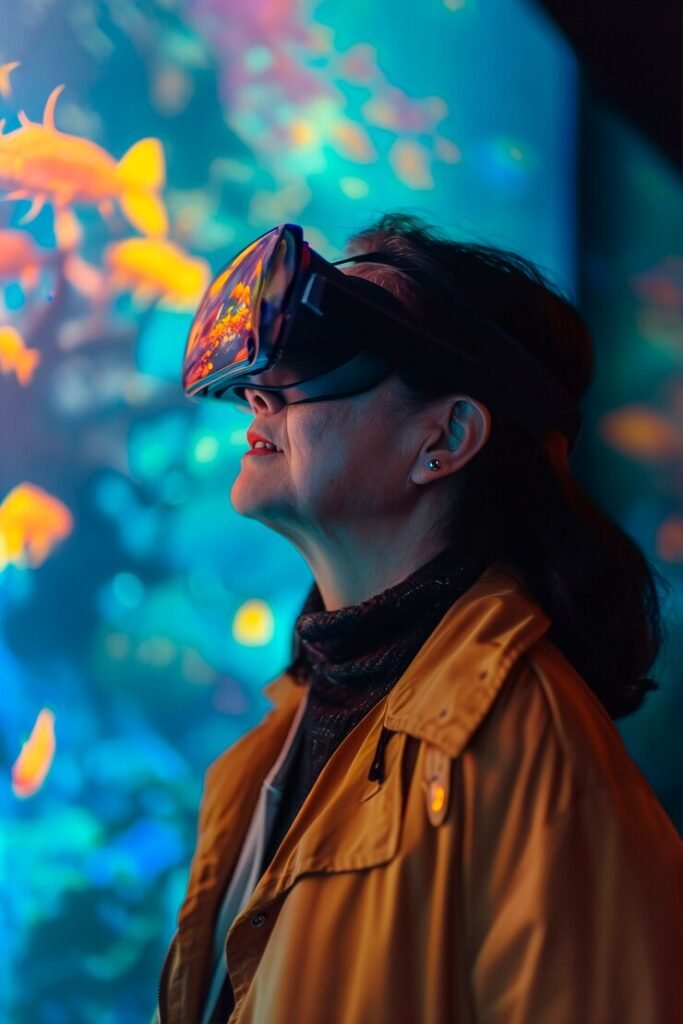Exploring the World of Immersive Technologies: A Gateway to the Future
In recent years, technology has evolved in ways we could only imagine a decade ago. Virtual reality (VR) and augmented reality (AR) are two examples. These immersive technologies are reshaping industries and how we experience the world. But what exactly are immersive technologies, and how are they transforming our everyday lives? In this blog post, we’ll dive into the world of immersive technologies. We’ll cover its applications in entertainment, education, and even its impact on niche fields like museums and heating systems. Let’s take a closer look at immersive technologies, with a focus on Immersive Technologies LLC and some cool applications.
What is Immersive Technology?
Immersive technology refers to digital experiences that fully engage the senses. These technologies create environments or simulations that feel as real as possible. At its core, immersive technology blurs the line between the physical world and the digital one. It can be achieved using virtual reality (VR), augmented reality (AR), mixed reality (MR), and 360-degree videos.
Immersive technology often uses headsets or specialized equipment. These tools enhance the sensory experience. For example, a VR headset creates a completely virtual world. Alternatively, AR glasses overlay digital elements onto the real world. Immersive technology is about making you feel like you’re “in” a different reality.
Immersive Technologies in the Museum World
- Immersive technologies have made their way into the art and culture world. Imagine walking into a museum and not just observing exhibits. Instead, you fully experience them. This is where the Museum of Immersive Art & Technology comes into play.
- Museums worldwide are embracing immersive technologies. They’re bringing art to life in new ways. At the Museum of Immersive Art & Technology, visitors explore interactive exhibits. Instead of simply observing from a distance, visitors engage with the digital art. This creates an immersive experience that involves both the mind and body.
- For example, visitors might walk through a space where digital projections respond to their movements. Alternatively, they may interact with artwork that changes in real-time. These exhibits break down the barrier between the observer and the art. It’s not just about seeing art—it’s about becoming part of it.
Immersive Technology in Education
In education, immersive technology is revolutionizing learning. Traditional classroom settings have limitations. But with immersive technology, learning is an experience beyond textbooks and lectures.
With VR and AR, students now immerse themselves in hands-on environments. Imagine a biology class where students step inside the human body to see how organs function. Or a history lesson where students travel back in time to witness historical events. These immersive experiences engage students and enhance understanding.
Immersive technologies also make remote learning possible. VR headsets allow students to attend virtual classrooms. Students can interact with peers and instructors in real-time, making education more accessible.
The Rise of Immersive Technologies LLC
As immersive technologies grow in popularity, companies like Immersive Technologies LLC are leading the way. Immersive Technologies LLC develops advanced immersive experiences for many industries, from entertainment to education.
What sets Immersive Technologies LLC apart is their blending of cutting-edge hardware and software. They create high-quality immersive experiences. Whether developing VR simulations for medical training or creating interactive AR experiences for retailers, their work is shaping the future. They cater to businesses and organizations looking to integrate immersive technology into their operations.
Immersive Technology in Heating Systems: The Role of Process Technology Immersion Heaters
Immersive technology is also making its way into unexpected industries. One example is the heating and industrial sectors. Process technology immersion heaters are a specific application in these industries.
A process technology immersion heater heats liquids or gases in industrial settings. The heater works by immersing a heating element directly into the material being heated. This allows for more efficient heat transfer. By using immersive technology, these systems can improve user interfaces, maintenance, and real-time monitoring.
Incorporating AR or VR into heating systems can also improve the experience. Workers can interact with heating systems more intuitively. For example, workers can virtually “see” the interior of a heating system and diagnose issues. This reduces the need to physically open the equipment. As a result, efficiency increases, and downtime is reduced.
Applications of Immersive Technology Across Industries
Immersive technologies have applications across many industries. The gaming industry uses VR and AR extensively, but other sectors are joining in. In healthcare, VR is used for surgical training. It allows doctors to practice procedures in a risk-free, immersive environment. In real estate, AR enhances property tours, allowing buyers to explore properties remotely.
Immersive technology is also changing marketing. Businesses can engage customers through interactive ads and virtual shopping experiences. Even in architecture, VR allows designers and clients to walk through virtual models of buildings before construction begins.
Challenges and Future of Immersive Technology
Despite its potential, immersive technology still faces challenges. For example, the cost of high-end VR and AR equipment can be a barrier for smaller businesses or schools. Additionally, the technology is still developing. Issues like motion sickness in VR or limited AR content can hinder widespread adoption.
However, with advancements in hardware and content, the future of immersive technologies looks promising. As costs decrease and content expands, more industries will integrate immersive technologies into their operations. This will create new opportunities for innovation and growth.
Conclusion
Immersive technologies are changing how we learn, create, and interact with the world. From transforming education and art to revolutionizing industrial processes with process technology immersion heaters, immersive technologies are paving the way for a more interactive and engaging world.
Companies like Immersive Technologies LLC are leading the charge. They help businesses harness immersive experiences and stay ahead of the competition. As technology continues to evolve, immersive technology will shape the future. Whether you’re exploring a museum, training with VR in education, or enhancing industrial operations, immersive technology is here to stay.
